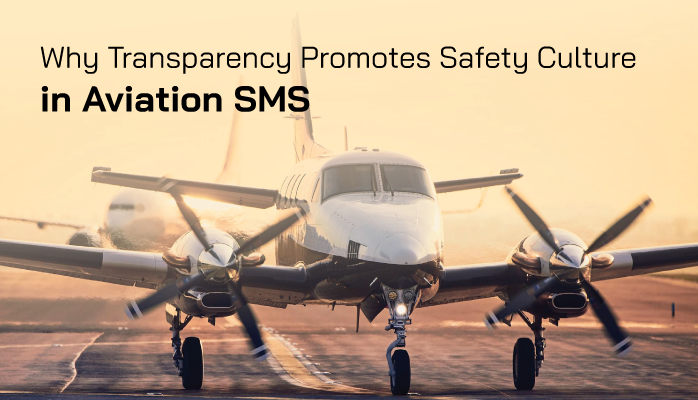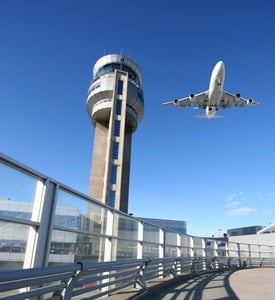Transparency, a Hot Topic:

In recent years, managerial concerns surrounding organizational transparency have become extremely important at all levels of industry and government. So important in fact, that most sensational news stories in recent years - namely Edward Snowden, Wikileaks, the Sony Hack, Bradley Manning - are issues of organizational transparency.
For individuals who defend transparency, we even have a name that has acquired the show-stopping power of words like "terrorist", "hero," or "whistle blower."
Related Aviation SMS Transparency Articles
- Overcoming Resistance to Change Through Transparency in Aviation SMS
- Transparency and Aviation Safety Data Security
- Why Transparency Promotes Safety Culture in Aviation SMS
While many may agree that industries like business, government, and military would have a more "engaged" workforce and garner more support if they chose more transparent practices, it is a particularly sensitive subject in the aviation industry for several reasons, including:
- security (personal, career, organizational, and industry);
- employee morale;
- managing corporate reputation;
- protection of organizational procedures providing competitive advantages; and
- managerial concern for control.
Transparency Debate in Aviation Safety Cultures
- Greater transparency about safety issues would seem to create
- more focus on safety
- greater awareness of safety issues
- increased hazard identification abilities with increased safety reporting;
- higher employee engagement in the providing of safe services;
- more proactivity, i.e. a healthier safety culture
- But there is a strong argument that aviation safety transparency could expose exploitable safety "holes"
- For workers in the industry, reporting a safety hazard could very well mean "blowing the whistle" on your co-workers, immediate supervisor, and friends
Basically, this is one of those subjects wherein there are no easy answers. When there are answers, they are not necessarily what one wants to hear. When healthy safety cultures exist, there is no fear of reprisal when either:
- self-reporting; or
- reporting observed potentially unsafe behavior.
Before we look specifically at transparency, let's refresh ourselves on the fundamental model underlying aviation safety management.
Related Aviation Safety Culture Articles
- What Does Aviation Safety Culture Look Like?
- 6 Signs of a Mature Aviation Safety Culture - With Resources
- How to Tell Your Safety Culture Needs Help? - With Aviation SMS Resources
The Reason Model: The Swiss Cheese Defense
As many of you are probably already well aware, in 1990 professor James T. Reason published Human Error, which analyzed primary factors in workplace accidents, and provided a framework for understanding how those accidents occurred. Another way of understanding this model is the relationship between hazards and accidents.

This framework is now widely regarded as the "Swiss Cheese Model." This model is the foundation of understanding the defense layers of aviation safety, among other industries such as cybersecurity.
The model basically works like this:
- Top level decision makers create certain safety policies
- Each of those policies has certain procedures
- These practices are implemented in the workplace and are supervised
- All workplaces have hazardous preconditions, such as environment or psychological factors
- There will always be unsafe acts in the workplace
- If all 5 of the previous steps line up in the right way, accidents, i.e. losses, will occur
An important part of this model is that it is a top-down model. When applying this model to the work environment, allows safety managers to focus on several things:
- It stresses that unsafe acts will happen but many more preconditions need to be met for an accident to occur
- Therefore, we can focus on the accident's preconditions for happening, rather than just the unsafe act
- Empowers the idea of a system as a means of risk management, hence aviation safety management systems (SMS)
- A proactive philosophy: if enough defenses are in place and carried out correctly, accident "X" should not occur
I especially highlight the importance of the last bullet point. Properly administering an aviation SMS with limited resources is the ultimate goal and challenge of safety managers, and it is vitally linked to safety transparency in the workplace.
What Safety Transparency Looks Like in the Workplace
What safety transparency boils down to is this: how much access to safety-related information do workers have in a workplace? It's a simple concept:
- If safety information about incidents X, Y, and Z is hidden from the workplace's population, then that is a lack of safety transparency
- If safety information about incidents X, Y, and Z is easily available to the workplace's general population, then that is safety transparency
But like most simple concepts, the intricacies of real-world application greatly complicate matters. What about more sensitive safety issues like:
- Management circumventing policies, practices, etc.
- Reporting on an individual, when the reporter's identity would be known
- Audits
Naturally, absolute transparency isn't always practical - especially because sensitive issues can often require investigation. Whether or not to release sensitive issues is as much a philosophical question as a practical one. In the worst instances, reporting for behavior not protected by the non-punitive reporting policy becomes incredibly sensitive. These behaviors may include:
- substance abuse;
- criminal intent;
- willful negligence; or
- intentional violation of aviation or company procedures.
While we are on the topic, make sure your non-punitive reporting policy explicitly states what behavior is not protected.
Related Articles on Non-Punitive Reporting and Transparency
- How to Write Non-Punitive Reporting Policy for Aviation SMS Programs - Free Templates
- Privacy, Transparency, and Confidentiality in Aviation Safety Management
- How to Practice Safety Transparency and Just Culture in SMS
Transparency Support Engaged Safety Cultures
Though we may cringe at making certain safety reports public, a transparent work environment will support an extremely high level of employee engagement.
But how transparent should a work environment be?
Nearly 100% - everything but information that is essentially impossible to release.
If a reported issue is affecting any person, in principle it should be available to the general workforce because such a level of transparency promotes a safety culture.
Let's look at the main reasons why.
Transparency Promotes a Culture of Safety as a Line of Defense

Three arguments against transparency, namely
- exposing exploitable safety holes that could damage company reputation;
- publicly exposing coworkers/friends potentially dangerous behavior; and
- unintentionally disclosing medical or sensitive employee identification data.
These arguments are generally short-term considerations when discussing an organization's policy of transparency.
With safety issues that carry a medium to a high level of risk, countermeasures are obviously taken immediately to mitigate risk to
- people;
- property;
- environment; and
- company reputation.
Transparency only helps in this regard. By sharing all information regarding safety concerns in the workplace, workers can:
- Be aware of the safety risk
- Help address the safety risk
- Proactively avoid accidents related to the risk
- Understand what types of hazards to remain vigilant of
- Learn risk management processes to encourage safety reporting
- Use learned safety information in daily lives to reduce injury and organizational risk from "not-job" related injuries
Timely action must be taken to address the safety risk when hazards are identified. When the workforce is aware of a particular safety issue, then it is actually much less exploitable than if the hazard or safety report were kept confidential, namely because no one would be "looking out" for the identified hazard.
Traditional safety programs may have managers introduce either new or modified policies and procedures in response to reported safety concerns. Employees may grumble or scratch their heads about why "new rules" are being made without understanding the change's nexus or reasoning behind the change. This type of safety culture is not a trusting or transparent safety culture.
Related Aviation Risk Management Articles
- Going from Reactive to Predictive Risk Management in Aviation SMS
- How to Practice Reactive, Proactive, and Predictive Risk Management in Aviation SMS
- 5 Indicators of Reactive or Proactive Safety Culture in Your Aviation SMS

Reporting on Friends - Transparency's Effect on Safety Culture

Then there is a common problem of reporting on friends/coworkers/etc., without fear of retaliation. When coworkers' inappropriate behaviors or errors are made public to the remainder of the workforce, there is a chance of giving the reporter a sort of "whistle-blower" status. The threat of retaliation toward the reporter becomes clear both to the reporter and to managers who need to effectively manage a "harmonious, productive workplace."
This issue is tougher to arrive at a clear-cut, definitive answer. In many safety cultures, this can be a tough hurdle to overcome. The fact is that many work environments struggle with genuine non-punitive reporting cultures, and suffer from a lack of safety reporting because of it. This becomes more evident as we work with aviation service providers in Southeast Asia and Latin America. Nobody wants to be seen or labeled as "The Rat."
What is hard as a safety culture is switching the mindset from
- "reporting on individuals" to
- "looking out for the safety of the workplace."
This cultural mind-shift has the same end goal as exposing safety hazards that can manifest themselves due to a lack of effective controls in the "system's design." The exposed behavior is always a gap in system design and should never be focused on the individual, except in cases of:
- criminal intent;
- substance abuse; or
- willful negligence.
As these behaviors are exposed, management can improve processes to prevent recurrence through the implementation of controls, such as:
- Administrative controls (more policies and procedures);
- Detective controls (allow for continuous monitoring of particular behaviors); or
- Engineering controls (redesign the system in response to detected behavior).
Attaining transparency in aviation SMS is a fundamental precept of making operating environments a "safe place to work" - of helping keep a workplace proactive rather than the place where one "tattle-tales," and becomes "The Snitch."
When management demonstrates that rigid transparency is enforced even at upper levels, it promotes a healthy safety culture in the general working population, which includes:
- Openness
- Honesty
- Integrity
"No secrets" is the foundation of trust in any relationship. It creates better lines of communication and removes barriers between management and the general workforce.
To boil it down to a single sentence - "Transparency at all levels of the workplace promotes a just reporting culture"
A just reporting culture is a healthy safety culture and a foremost line of resistance in preventing accidents, or "losses."
Like I said, implementing a rule of transparency is not easy, especially when it comes to embarrassing or sensitive issues - with such issues, the instinct is strict confidentiality. But I would like you to look very hard at such issues and decide if confidentiality is absolutely necessary.
In most cases upholding transparency will be healthier for the safety culture of your workplace, and the success of your SMS. Transparency starts at the top.
Related Articles on Aviation SMS Risk Controls
- Difference Between Hazards, Risks & Control Measures in Aviation SMS
- How to Implement Effective Control Measures
- How to Evaluate Risk Controls and Risk to Aviation SMS Implementations
Summary
Let's take an overview of how transparency, safety culture, and the Swiss Cheese Model work together:
- Transparency promotes an enhanced safety culture
- Better safety culture focuses on the system of safety and not the individual
- The system of safety cultivates proactive awareness and reporting
- Proactivity strengthens safety defenses and provides more reliable AND valuable SMS data
- Strong defenses mean fewer "holes in our cheese"
- Fewer holes in our cheese make transparency easier to enforce
It's a revolving door. But the main point is that Transparency leads to better relationships and therefore lines of defense.
When new safety issues arise that have not been properly mitigated, or when workers practice unsafe acts, there will be many other people standing between the hazard and "The Accident." We know with certainty that "The Accident" is coming. We do not know "when" The Accident is coming or "where." But we do know "why."
By developing healthy safety reporting cultures, aviation service providers can continuously monitor SMS performance by
- reviewing risk controls; and
- developing or strengthening weak controls.
When safety concerns are not reported, there are fewer opportunities to review risk controls and improve underlying processes.
Furthermore, I think we can all agree that working in an environment where you trust and feel trusted is a pretty good spot to be.
To improve safety reporting culture, you need tools that allow employees to:
- quickly and easily report safety concerns;
- receive immediate feedback that their concern is being addressed;
- "self-follow up" without taxing safety managers' time; and
- learn what is currently being done to address their safety concern in real-time without long waits.
From management's perspective, safety teams need to be able to quickly and efficiently:
- evaluate risk from reported safety concern;
- categorize for future trend analysis; and
- document risk management activities.
When your aviation SMS lacks an efficient safety reporting system integrated with a solid risk management system designed specifically for the aviation industry, your safety reporting culture will never flourish.
Are you having trouble with safety culture and safety reporting? We can help. Since 2007, we have been providing the best aviation SMS database software on the market. Each day, I become more confident that SMS Pro is the best database software because our clients have been repeating this same story for years. I'm beginning to believe them.
Do you want the best SMS database tools? We have them. I'm a modest person and never liked being around braggarts. But when safety managers continue to tell me: "I've looked at lots of solutions when I was looking for SMS tools, including;
- Q5;
- ETQ;
- QPulse;
- Vistair;
- Vortex;
- Prism;
- Baldwin."
The story is always the same. What is funny to me is that aviation safety managers compare SMS Pro to the competitors using "automobiles" instead of aircraft. They call SMS Pro the "Cadillac" or "Rolls Royce" of SMS databases. I'm not saying anything bad about our competitors. But SMS Pro's price is not out of line and is often less expensive than competitors.
We want to be your SMS Partner.
SMS Pro is only sold to the aviation industry because it was built to address regulatory SMS requirements, whether you are in:
- Canada;
- Europe;
- Asia;
- United States; or
- Australia.
SMS Pro impresses SMS auditors.
See SMS Pro's SMS Database in Action
Last updated July 2025.









